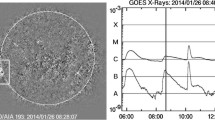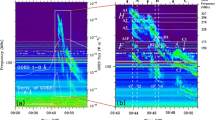Abstract
We report on the analysis of a fast (>2,000 km/s) CME-driven shock event observed with the UVCS telescope operating aboard SoHO on 23 July 2002. The same shock was also detected in the metric band by several ground-based radiospectrographs. The peculiarity of this event is the presence in the radio spectra of two intense metric type II bursts features drifting at different rates, together with clear shock/related broadenings of the O VI doublet lines observed by UVCS that were found to be temporally associated with the above radio features. The nature of these multiple radio lanes in the metric band is still under debate. One possible explanation is that they are produced by multiple shock waves generated by different ejections or, alternatively, by the flare and the associated CME. Also, emission from the upstream and downstream shock regions can produce split bands. By adopting a plausible CME model, together with a detailed analysis of the white-light, UV, and radio data associated with this event, we are able to conclude that both the radio and the UV shock signatures were produced by a single shock wave surface generated by the expanding CME.
Similar content being viewed by others
Avoid common mistakes on your manuscript.
1 Introduction
Coronal mass ejections (CMEs) with speeds in excess of the ambient magnetosonic speed eventually drive shocks ahead of them. Shock waves accelerate electron beams, which in turn can produce Langmuir waves that are converted into type II radio waves near the fundamental of the local electron plasma frequency f pe ≈ 9n 1/2 e KHz and its harmonic, where n e is the electron density in cm−3. Since the coronal density decreases with increasing heliocentric distance, the expanding shock surface will produce type II radio emissions at decreasing frequencies as it propagates through space. The observed frequency drift rate provides therefore information on the shock dynamics through the corona. Direct imaging of coronal shocks remains an outstanding observational challenge. While some features of CMEs observed in the corona in white-light have been interpreted as signatures of shocks, it is generally difficult to differentiate between hot, shock-compressed plasma and coronal ejecta such as loops and prominence material. Clear signatures of shock formation in the corona have been observed with the Ultraviolet Coronagraph Spectrometer (UVCS) on board the Solar and Heliospheric Observatory (SoHO) and were identified by wide and sudden broadenings of the O VI spectral line profiles, together with simultaneous brightenings of the spectral lines from heavier ions (e.g. Mancuso et al. 2002).
According to the spectra recorded by several ground-based radio observatories on 2002 July 23, strong type II emission was detected at the time corresponding to a fast CME passage through the UVCS slit, which was placed near the east limb to a mirror height of 1.63 R\(_{\odot}\) from the center of the Sun, with the point along the slit closest to the Sun at an angle 96° from north pole. Sudden shock-generated broadenings of the O VI λ1032 Å spectral line profiles were detected simultaneously in UV by UVCS. Above the UVCS slit height, a fast, eastward-propagating CME associated with the flare was first visible in difference images at 00:42 UT with the Large Angle and Spectrometric Coronagraph (LASCO) C2 instrument on board SOHO. Figure 1 shows a composite image of the 23 July 2002 CME obtained by combining running-difference images taken from various instruments.
We modelled the observed eruption as a conically expanding bubble-type CME in which the apex of the cone is located at the center of the Sun, as in Mancuso and Raymond (2004) and Mancuso (2007). The propagation of the CME along its axis of symmetry (roughly perpendicular to the UVCS slit) was estimated from the available white-light and UV data by measuring the plane-of-sky heliocentric distance of its leading edge in units of the solar radius. This information was used to infer the CME height-time trajectory by least-square fitting the available data with a cubic polynomial. The ice-cream CME model described above, expanding at the rate imposed by the observational constraints, was used in order to build a synthetic metric dynamic spectrum for this event. A global overview of the complex multi-lane metric radio emission associated with this event is displayed in Fig. 2a. In order to model the observed radio emissions, that is, converting the height-time data to the corresponding frequency-time relationship, we used a coronal electron density profile appropriate for solar maximum conditions. Figure 2b shows the model dynamic spectrum superimposed to selected lanes of actual radio measurements (stars) extracted from the Learmonth radio dynamic spectrum. The upper (split) bands were not plotted to avoid confusion. The solid lines represent the frequencies emitted from a type II radio-emitting source propagating through the model density profile along the axis of symmetry of the CME and just above the CME leading edge. The dashed lines are the model frequencies that refer to type II emissions by a source propagating along the flanks of the CME envelope. The match between observed and model data is outstanding. The above result suggests that the 2002 July 23 radio emission was produced by a unique shock surface and not by different ejections emitted at different times and/or by a blast wave originated from the associated flare. This implies that the shock observed in UV by UVCS was indeed CME-driven, with the type II emissions presumably located both near the top and the flanks of the CME expanding leading edge.
Toppanel The dynamic spectrum of the 23 July 2002 event observed by the Learmonth radio spectrograph. Bottom panel Model dynamic spectrum superimposed to actual radio measurements extracted from the above radio dynamic spectrum. The solid line represent the frequency emitted from a source propagating through the model density profile along the axis of symmetry of the CME. The dashed line is the model frequency emitted by a source propagating along the CME flanks
References
S. Mancuso et al., Astron. Astrophys. 383, 267–274 (2002)
S. Mancuso, J.C. Raymond, Astron. Astrophys. 413, 363–371 (2004)
S. Mancuso, Astron. Astrophys. 463, 1137–1141 (2007)
Author information
Authors and Affiliations
Corresponding author
Rights and permissions
About this article
Cite this article
Mancuso, S., Avetta, D. Origin of the Multiple Metric Type II Radio Burst Structure Associated with the 2002 July 23 CME. Earth Moon Planet 104, 105–108 (2009). https://doi.org/10.1007/s11038-008-9255-x
Received:
Accepted:
Published:
Issue Date:
DOI: https://doi.org/10.1007/s11038-008-9255-x






